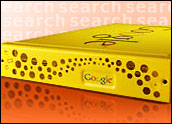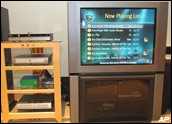
Google is amping up its corporate search tool by more than tripling its capacity compared to previous models. The newly launched Google Search Appliance boasts the ability to index up to 10 million documents with a single, bright yellow server.
The development — Google’s fifth offering in the Search Appliance family — is also said to deliver results as much as five times faster than its predecessor. It offers a handful of other updated features for end users at corporate clients.
Size Matters
The biggest change all comes down to size: jumping from a 3 million to a 10 million document capacity without increasing the dimensions of the device.
“A typical enterprise search deployment would require dozens of servers if you have a scale of 10 million documents — with multiple back-end databases, Web servers, content servers, and all that stuff,” Google Enterprise Project Manager Nitin Mangtani told TechNewsWorld. “We have done some really core architectural changes to simplify the entire search … so the administrators and IT departments just need to manage one server to scale the 10 million documents,” he explained.
It took an overhaul of both hardware and software to achieve the results. Engineers tweaked the crawling system to improve speed and also installed improved central processing unit cores and memory. It’s effectively a “brand new hardware and software platform,” Mangtani said.
Feature Focus
Speed and size aside, Google wanted to have its updated Search Appliance — powered once again by Dell technology — focus on features that’d make it easier to use. One of the changes is improved search for different kinds of content, including enterprise systems such as Microsoft SharePoint, IBM FileNet, and OpenText Livelink. Another is personalization: Administrators can set up different user groups to define individual search parameters for specific subsets. One department, for example, might want to see code-related documents at the top of its search, while another might want marketing-related results up high.
Other added features include the option for e-mail alerts on specified topics or documents, advanced search analytics, and improved encryption. The Search Appliance also now supports Kerberos and has expanded international support for UK-style spelling as well as Portuguese, Turkish and Vietnamese.
“The idea of the hardware is really simplicity,” Mangtani commented. “You plug and play and you’re up and running.”
Business Adoption
Plenty of businesses are getting on board with that idea. Google claims 20,000 Search Appliance clients, ranging from Adobe to Kimberly-Clark — and even NASA.
“[With] any organization or business entity which has a lot of digital content … the main problem for them is they have done some massive investments in content depositories and tools all for the digital content. But all that investment is not fruitful until you can find the right document you are looking for,” Mangtani pointed out.
In our information-centric age, effective search is quickly becoming a necessity for any business. Regardless of what system is used, having a powerful process in place can make an immeasurable difference in productivity — and, ultimately, in profit.
“The effective search is obviously critical in the world of the Internet,” Charles King, principal analyst at Pund-It, told TechNewsWorld. “There’s really astounding growth in the sheer amount of information and documents that companies are storing and attempting to manage successfully,” he said.
While 10 million documents may seem like an astronomical number, it’s no longer unattainable, according to King.
“The more than tripling of capacity on the new appliance … isn’t simply a matter of bigger, better or best. It’s really, I think, a response to a very serious issue that more and more companies are facing — and that’s how to efficiently work with and effectively leverage the information that they continue to collect and store,” he noted.
Google’s Search Appliance starts at US$30,000 for its entry-level model. The higher-end devices — including custom-made ones that can handle up to 30 million documents — are priced only on an individual, private basis.





















































